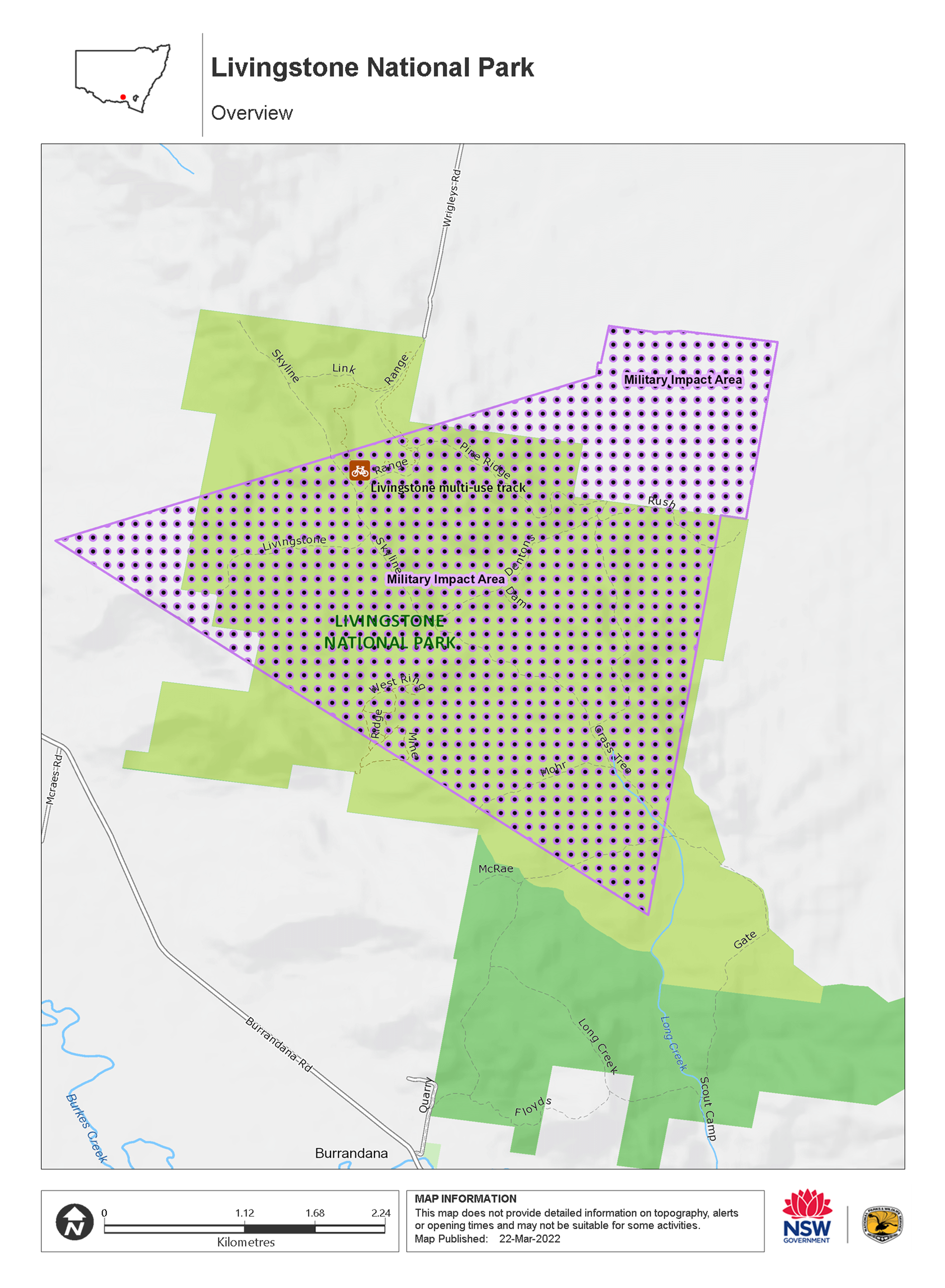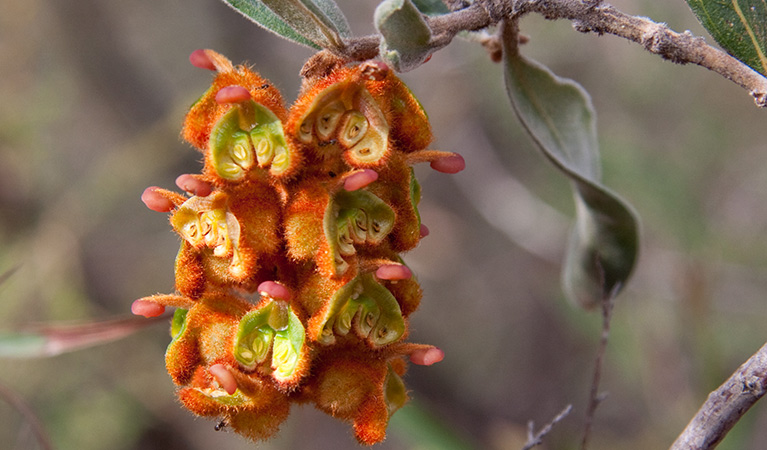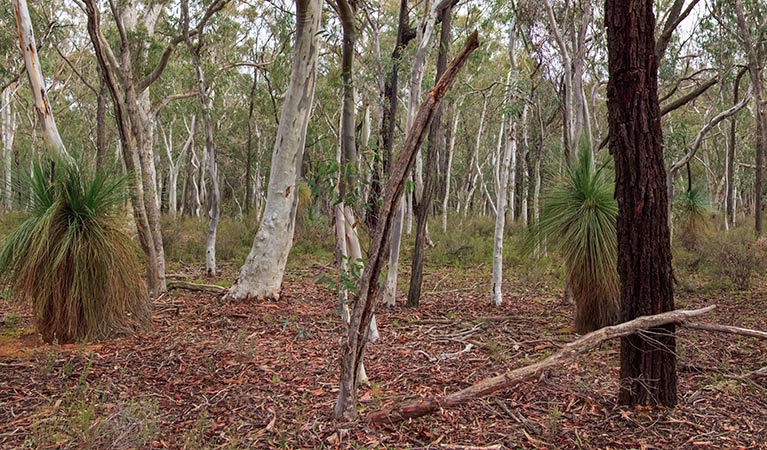Livingstone National Park
Overview
Close to Wagga Wagga, Livingstone National Park and Livingstone State Conservation Area are great for camping, mountain bike riding, horse riding, picnicking, 4WD touring and birdwatching.
Read more about Livingstone National Park
Just 30km south of Wagga Wagga, Livingstone National Park and the nearby Livingstone State Conservation Area boast close to 2,000ha of richly varied bushland. Wherever you travel throughout the park, you’ll be struck by the diversity of the ever-changing landscape. In spring, when all the native wildflowers burst with colour, including several species of orchids, the landscape is simply spectacular. Austral indigo, kangaroo thorn and clustered everlasting are a must-see at this time of year.
Take a walk, mountain bike or enjoy a horse ride along Livingstone multi-use track. Birdwatchers will enjoy the chance to spot many threatened woodland birds, including turquoise and swift parrots and scarlet and hooded robins. You’ll also glimpse eastern grey kangaroos, swamp wallabies, wombats and goannas on your adventure through Livingstone National Park.
Local alerts
For the latest updates on fires, closures and other alerts in this area, see https://uat.nswparks.cloud/visit-a-park/parks/livingstone-national-park/local-alerts
Contact
- in the Murray-Riverina region
Livingstone National Park is always open but may have to close at times due to poor weather or fire danger
-
-
Tumut Region Visitor Centre
02 6947 7025
Contact hours: 9am to 5pm daily. Closed Christmas Day. - The Old Butter Factory, 5 Adelong Road, Tumut NSW 2720
-
Email: tumutrvc@environment.nsw.gov.au
-
Tumut Region Visitor Centre
Visitor info
All the practical information you need to know about Livingstone National Park.
Map

Map legend

Maps and downloads
Nearby towns
Wagga Wagga (30 km)
Wagga Wagga is renowned for its stunning parks and award-winning gardens. Take a tour through the 20 hectares of themed garden beds in the beautiful Wagga Wagga Botanic Gardens complete with mini zoo and free-flight aviary.
Henty (57 km)
Henty is known for its connections with notorious bushranger Dan 'Mad Dog' Morgan. It's also where Headlie Taylor, a citizen of Henty, invented the grain harvester in 1914. Take the Henty Historical Village Walk to learn more about the town's history.
Junee (69 km)
Don't miss the exhibits of the huge Junee Roundhouse Railway Museum. The Roundhouse, complete with a 33-m turntable and 42 tracks, was the last steam train depot built in NSW.
Learn more
Livingstone National Park is a special place. Here are just some of the reasons why:
Wild about wildflowers and wildlife

During spring, you'll see an abundance of beautiful plants flowering in Livingstone. Bursts of purple Austral indigo interspersed with yellow kangaroo thorn, cream-coloured grass trees, and nodding blue lily (which is actually purple) form a kaleidoscope of vibrant colours. A population of Yass Daisy, a threatened species, occurs in Livingstone - the most south-westerly limit of its known range. Six distinctive forest ecosystems here make for a uniquely varied, interesting landscape. The park also contains a diverse range of native animals, including 5 amphibian species, 9 reptile species, 15 mammal species, and 185 species of birds. Many threatened species have been recorded here, and it's a sanctuary for swift, superb and turquoise parrots, barking owls, hooded robins, and diamond firetails.
- Livingstone loop track Livingstone loop track is a great multi-use track you can enjoy while bushwalking, bird watching, mountain biking or horse riding near Wagga Wagga.
Pastoral historic heritage

Livingstone National Park was once pastoral holdings until the area was converted to a state forest in 1917. Continuous, though limited, mining occurred from 1872 to 1950, and again in the early 1980s. Early mining activity was for gold and, in later times, wolframite. Today, there is still evidence of trenches, mullock heaps, and mine shafts.
Lands of plenty

Livingstone National Park is Wiradjuri Country. The land and all within it has great importance to local Aboriginal spirituality and culture - art, ceremonial sites and spiritual places are throughout this outstanding landscape. Many plants, such as grass trees and mugga ironbark, have been used to produce shields, medicine and boomerangs. Livingstone is covered by the Wagga Wagga Local Aboriginal Land Council, so when you're in this country, you're in a place where Aboriginal culture is integral to its past, present and future.
Education resources (1)
What we're doing
Livingstone National Park has management strategies in place to protect and conserve the values of this park. View the detailed park and fire management documents.

